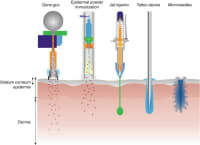Covid-19 Vaccines
Little is known about their side effects.[1]
Lymphadenopathy
Post-vaccination lymphadenopathy is swelling of lymph nodes. Lymphadenopathy typically happens in reaction to bacterial, viral, or fungal infections, autoimmune disease, and malignancy.[2]
-
It has been reported that the median time from the first vaccination to lymphadenopathy detection was 2–29 days.[2:1]
-
It was also reported that post-vaccination lymphadenopathy was found at 127 ± 43 days after the first vaccination.[2:2]
-
The number of vaccine recipients who were found to develop axillary lymphadenopathy, including subclinical axillary lymphadenopathy, was larger than that of recipients with axillary pain and swelling reported in the clinical trial.[2:3]
-
Breast ultrasonography after COVID-19 vaccination revealed axillary lymphadenopathy on the side of the vaccination in as many as half of the recipients.[2:4]
-
Morphologically abnormal lymph nodes are found at the higher levels (levels II/III), and normal lymph nodes are found at the lower level (level I) after COVID-19 vaccination.[2:5]
-
The number of visible axillary lymph nodes in both areas was significantly higher in the vaccine group.[2:6]
-
Lymphadenopathy probably occurred due to the vaccination.[2:7]
Diabetes
- A link between COVID-19 vaccination, specifically Pfizer-BioNTech, with latent autoimmune diabetes in adults.[1:1]
- Cases have been reported with new-onset Diabetes Mellitus with DKA/HHS (Diabetic ketoacidosis and hyperosmolar hyperglycemic state) after administration of the vaccine, with one case series describing hyperglycemic crises precipitated by Pfizer and Moderna vaccines.[1:2]
- Several hypotheses have been proposed to explain how SARS-CoV-2 may trigger new-onset or exacerbate known DM, including:
- (1) SARS-Cov can infect pancreatic beta cells directly, or cause direct or bystander destruction of pancreatic beta cells by binding to pancreatic angiotensin-converting enzyme 2 (ACE2) receptors.[1:3]
- (2) Releasing of cortisol and catecholamines because of the acute stress caused by SARS-CoV-2.[1:4]
- (3) Disruption of the renin-angiotensin-aldosterone and angiotensin 1-7 balance, favoring upregulation of the pro-inflammatory angiotensin II pathway with downregulation of the vasodilatory, protective angiotensin 1-7 pathway with local, detrimental effects at the pancreas.[1:5]
- (4) Infection will lead to dysregulation of the immune system, triggered systemic inflammatory response and release of cytokines, a “cytokine storm.” [1:6]
- An obese patient, who had been pre-diabetic for more than 20 years, suddenly presented with DKA (Diabetic ketoacidosis) only a few days after COVID-19 vaccination, with positive autoantibodies and requiring insulin.[1:7]
- Severe hyperglycemia including HHS (hyperosmolar hyperglycemic state) and DKA (Diabetic ketoacidosis) may be triggered by COVID-19 vaccination.[3]
- The robust inflammatory response and “cytokine storm” may be the primary precipitant.[3:1]
- Data suggest that immune dysregulation caused by the vaccine may worsen diabetes and supports the hypothesis that a similar mechanism underlies the association between COVID-19 infection and diabetes.[3:2]
- COVID-19 vaccine may trigger hyperglycemia.[3:3]
- COVID-19 vaccine triggers a robust systemic inflammatory immune response.[3:4]
Graves Disease
Graves’ disease is an immune system disorder that results in the overproduction of thyroid hormones (hyperthyroidism).
- A link between COVID-19 vaccine and Graves’ disease cases has been hypothesized.[1:8]
- The vaccine is stated to contain four lipids, of which two are polyethylene glycol (PEG) lipid conjugates that stabilize the lipid nanoparticles and reduce the activity of non-specific binding proteins.[1:9]
- PEGs may act as an adjuvant and induce an immune response in predisposed individuals, as there are reports of reactions to PEGs.[1:10]
- There is not only a link between COVID-19 vaccines and diabetes but also a link with autoimmune conditions entirely.[1:11]
- Since Graves’ disease and LADA (Latent autoimmune diabetes in adults) are autoimmune pathologies, this theory possibly explains both.[1:12]
Title: COVID-19 Vaccine-Induced Latent Autoimmune Diabetes in Adults
Publication: Springer: Cureus
Institution(s): Internal Medicine, State University of New York Downstate Medical Center, Brooklyn, USA; Endocrinology, SUNY-Downstate, Health Science University, Brooklyn, USA
Archive: archive ↩︎ ↩︎ ↩︎ ↩︎ ↩︎ ↩︎ ↩︎ ↩︎ ↩︎ ↩︎ ↩︎ ↩︎ ↩︎Title: The location of unilateral axillary lymphadenopathy after COVID-19 vaccination compared with that of metastasis from breast cancer without vaccination
Publication: Japanese Journal of Radiology
Institution(s): Department of Radiology, St. Luke’s International Hospital, Tokyo, Japan
Archive: archive ↩︎ ↩︎ ↩︎ ↩︎ ↩︎ ↩︎ ↩︎ ↩︎Title: Hyperglycemic Emergencies Associated With COVID-19 Vaccination: A Case Series and Discussion
Publication: Journal of the Endocrine Society
Institution(s): Division of Endocrinology, Department of Medicine, Albert Einstein College of Medicine, Bronx, NY; Fleischer Institute for Diabetes and Metabolism, Montefiore Medical Center, Bronx, NY USA
Archive: archive ↩︎ ↩︎ ↩︎ ↩︎ ↩︎
